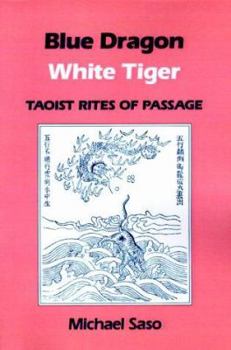Blue Dragon White Tiger: Taoist Rites of Passage
Select Format
Select Condition 
Book Overview
A view of Chinese religion from the Taoist perspective, derived from field work in Taiwan, Hong Kong, and the People's Republic of China, this book is based on the Taoist hypothesis that all Chinese rites of passage and festivals are structured by Yin-yang Five Element cosmology. Buddhist and Taoist meditation of emptying, marriage, birthing, initiation, burial, ancestor rituals, and the annual festivals are described through the eyes of the experts called on to serve family and village needs. The work ends with a view of religion in the People's Republic of China during a period of renewal and restoration.
Format:Paperback
Language:English
ISBN:0824813618
ISBN13:9780824813611
Release Date:October 1990
Publisher:Taoist Center
Length:232 Pages
Weight:3.20 lbs.
Dimensions:0.6" x 6.0" x 9.0"
Customer Reviews
3 ratings
It is a good book for western readers.
Published by Thriftbooks.com User , 19 years ago
The book is useful for western readers who are interested in Taoism (Taiwan only). However, I agree with some previous comments that the sub-title "Blue Dragon White Tiger" is not necessary. By the way, we Chinese say "Green Dragon White Tiger" actually, Green means East, Trees and wood, Growing etc while White means West, Metal and Fading etc. Most Feng-shui masters use the above theory as well as Taoist priests. If you want to know more about Taoism in academic aspects, I'd like to recommend "Daoist Identity - History, Lineage, and Ritual" edited by Livia Kohn.
Ian Myles Slater on: Chinese Religions' Foundation Concepts
Published by Thriftbooks.com User , 22 years ago
While I agree completely with the previous reviewer's enthusiasm, prospective readers should be aware that the "Taoist Rites of Passage" subtitle is slightly misleading. Although Michael Saso is best known for excellent works on Taoism in modern Taiwan (and latterly the mainland), "Blue Dragon White Tiger" is a description of the ritual life of Chinese popular religion (Confucian and Buddhist as well as Taoist), which closely relates the practices to underlying philosophical and cosmological concepts. I have found nothing at once so comprehensive and concise in English. Taoism, which most broadly and effectively incorporates distinctly Chinese concepts, does receive the major attention. These portions of the book cover some of the same material as Saso's earlier "Taoism and the Rite of Cosmic Renewal" (1972, revised 1989) and "The Teachings of Taoist Master Chuang" (1978; corrected edition as "Taoist Master Chuang," 2000). Taoism as a living religion has been seriously studied only in the last few decades, and Saso is a leading figure in this field. He has also worked on classical Taoist texts, non-Taoist popular beliefs, and Chinese Buddhism, however, so he is not presenting his own narrow specialization as the whole of Chinese religion. The publisher informs us that "camera-ready copy was supplied by the author," which gives the reader some confidence that the Chinese characters and the many charts, diagrams, and illustrations have been inserted at the right places. It may also account for some inconsistencies in layout, and possibly some less than sparkling passages on non-Chinese subjects. As mentioned, Saso's reports on Chinese practices, and the beliefs associated with them by at least some Chinese, are based on solid research and personal experience. The author acknowledges the assistance of various Chinese scholars and ritual specialists, and of western Sinologists, including several of the Jesuits who had assisted his earlier fieldwork on Taiwan with Master Chuang. It is, however, fairly obvious who DIDN'T check the text for errors. In a passage comparing rituals of adult status on page 134, his references to Judaism confuse Yom Kippur (the Day of Atonement -- part of a "world-renewal" ritual of a type familiar to Saso!) with the Bar Mitzvah (presenting a 13-year-old male as an adult for some important religious purposes). Not a big problem, but a sudden jolt to the reader who is aware of the difference. And a lost chance for an interesting comparison.
Taoism from the inside out
Published by Thriftbooks.com User , 24 years ago
"Blue Dragon White Tiger" is an in-depth description and explanantion of the underlying philosphies that have permeated Chinese culture from antiquity to the present day. This is not an exhaustive history, but an exploration of the major philosophies/practices that underpin Chinese society and cultural norms. Chief among these are the yin/yang concepts of the "I Ching" and the five-element (wood, fire, metal, water, earth) system of natural processes of change. My teacher Michael Saso is an initiated Taoist priest and ordained Buddhist priest, so he is able to give us a look at the various rites of passage of Chinese culture such as birth, death, marriage and the annual cycle of festivals from the inside out. He not only describes rituals as an observer, but understands the underlying energetic processes such as Taoist emptying that inform and empower the rites. This level of understanding is rare in the West, to say the least. While there are surely descriptions of these rites elsewhere, the inner meaning based on experience from practicing the Taoist alchemical inner transformation and emptying yogas eludes the most educated and astute scholar-observer. It is precisely this meaning that the author provides. He ends with an overview of the state of religion in China today. Each chapter has notes and a select bibliography, however there is no index.






